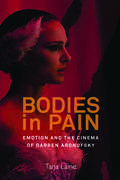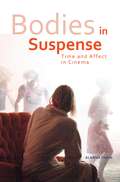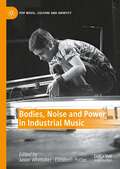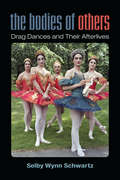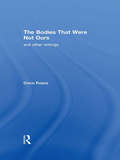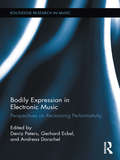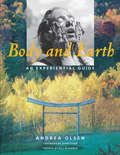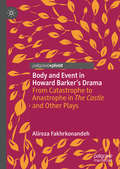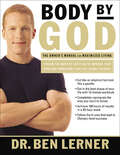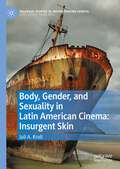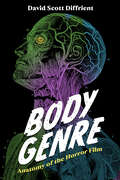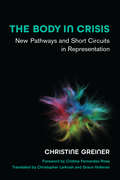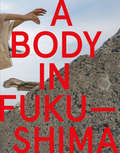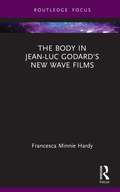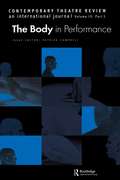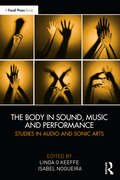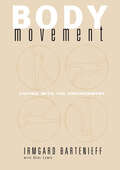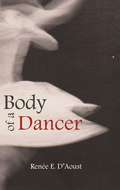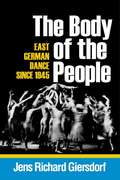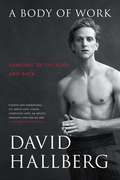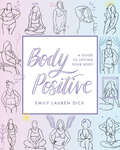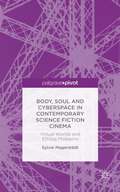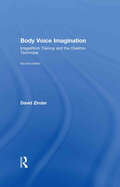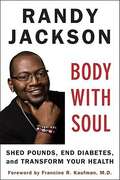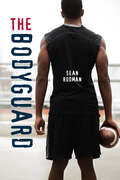- Table View
- List View
Bodies in Pain: Emotion and the Cinema of Darren Aronofsky
by Tarja LaineThe films of Darren Aronofsky invite emotional engagement by means of affective resonance between the film and the spectator’s lived body. Aronofsky’s films, which include a rich range of production from Requiem for a Dream to Black Swan, are often considered “cerebral” because they explore topics like mathematics, madness, hallucinations, obsessions, social anxiety, addiction, psychosis, schizophrenia, and neuroscience. Yet this interest in intelligence and mental processes is deeply embedded in the operations of the body, shared with the spectator by means of a distinctively corporeal audiovisual style. Bodies in Pain looks at how Aronofsky’s films engage the spectator in an affective form of viewing that involves all the senses, ultimately engendering a process of (self) reflection through their emotional dynamics.
Bodies in Suspense: Time and Affect in Cinema
by Alanna ThainBodies in Suspense presents a powerful new way to think through postdigital cinema and the affective turn in critical theory. According to Alanna Thain, suspense films allow us to experience the relation between two bodies: that of the film and that of the viewer. Through the “time machine” of suspense, film form, gender, genre, and spectatorship are revealed in innovative and different ways. These films not only engage us directly in ethical concerns, but also provide a key for understanding corporeal power in the digital era. Offering a new framework for understanding cinematic suspense, Bodies in Suspense argues that the “body in time” enables us to experience the temporal dimension of the body directly. This is the first book to link two contemporary frames of analysis: questions of cinematic temporality and contemporary affect theory. Thain conducts close readings of influential suspense films by Alfred Hitchcock, David Lynch, Christian Marclay, Rian Johnson, and Lou Ye, and sets forth a compelling new theory of cinema, reading for the productivity of the “crime of time” that stages the duplicity of cinematic bodies. Through these films that foreground doubled characters and looping, Thain explores Gilles Deleuze’s claim that “the direct time-image is the phantom which has always haunted cinema.”A vital new addition to film theory, corporeality and affect theory, feminist theory, and the philosophy of time—and one of the first books to explore David Lynch’s Hollywood trilogy—Bodies in Suspense asks us to pay attention, above all, to the ways in which the condition of spectatorship creates a doubling sensation with important philosophical repercussions.
Bodies, Noise and Power in Industrial Music (Pop Music, Culture and Identity)
by Jason Whittaker Elizabeth PotterThis edited collection delves into the industrial music genre, exploring the importance of music in (sub)cultural identity formation, and the impact of technology on the production of music. With its roots as early as the 1970s, industrial music emerged as a harsh, transgressive, and radically charged genre. The soundscape of the industrial is intense and powerful, adorned with taboo images, and thematically concerned with authority and control. Elemental to the genre is critical engagement with configurations of the body and related power. Adopting an interdisciplinary approach, this collection analyses the treatment of subjects like the Body (animal, human, machine), Noise (rhythmic, harsh) and Power (authority, institutions, law) in a variety of industrial music’s elements. Throughout the collection, these three subjects are interrogated by examining lyrics, aesthetics, music videos, song writing, performance and audience reception. The chapters have been carefully selected to produce a diverse and intersectional perspective, including work on Black industrial musicians and Arabic and North African women’s collaborations. Rather than providing historical context, the contributors interpret the finer elements of the aesthetics and discourses around physical bodies and power as expressed in the genre, expanding the ‘industrial’ boundary and broadening the focus beyond white European industrial music.
The Bodies of Others: Drag Dances and Their Afterlives (Triangulations: Lesbian/Gay/Queer Theater/Drama/Performance)
by Selby Wynn SchwartzThe Bodies of Others explores the politics of gender in motion. From drag ballerinas to faux queens, and from butoh divas to the club mothers of modern dance, the book delves into four decades of drag dances on American stages. Drag dances take us beyond glittery one-liners and into the spaces between gender norms. In these backstage histories, dancers give their bodies over to other selves, opening up the category of realness. The book maps out a drag politics of embodiment, connecting drag dances to queer hope, memory, and mourning. There are aging étoiles, midnight shows, mystical séances, and all of the dust and velvet of divas in their dressing-rooms. But these forty years of drag dances are also a cultural history, including Mark Morris dancing the death of Dido in the shadow of AIDS, and the swans of Les Ballets Trockadero de Monte Carlo sketching an antiracist vision for ballet. Drawing on queer theory, dance history, and the embodied practices of dancers themselves, The Bodies of Others examines the ways in which drag dances undertake the work of a shared queer and trans politics.
The Bodies That Were Not Ours: And Other Writings
by Coco FuscoInterdisciplinary artist and writer Coco Fusco is one of North America's leading interpreters of intercultural theory and practice. This volume gathers together her finest writings since 1995 and includes critical essays by Jean Fisher and Caroline Vercoe that interpret her work.Engaging and provocative, these essays, interviews, performance scripts and fotonovelas take readers on a tour of our current multicultural landscape. Fusco explores such issues as sex tourism in Cuba as a barometer of the island's entry into the global economy, Frantz Fanon's theorization of metropolitan blackness, and artistic and net activist responses to the effects of free trade on the Mexican populace. She interviews such postcolonial personnae as Isaac Julien, Hilton Als and Tracey Moffatt. Approaching the dynamics of cultural fusion from many angles, Fusco's satires, commentaries, and sociological inquiries collapse boundaries, and form a sustained meditation on how the forces of globalization impact upon the making of art.
Bodily Expression in Electronic Music: Perspectives on Reclaiming Performativity (Routledge Research in Music)
by Deniz Peters Gerhard Eckel Andreas DorschelIn this book, scholars and artists explore the relation between electronic music and bodily expression from perspectives including aesthetics, philosophy of mind, phenomenology, dance and interactive performance arts, sociology, computer music and sonic arts, and music theory, transgressing disciplinary boundaries and established beliefs. The historic decoupling of action and sound generation might be seen to have distorted or even effaced the expressive body, with the retention of performance qualities via recoupling not equally retaining bodily expressivity. When, where, and what is the body expressed in electronic music then? The authors of this book reveal composers’, performers’, improvisers’ and listeners’ bodies, as well as the works’ and technologies’ figurative bodies as a rich source of expressive articulation. Bringing together humanities’ scholarship and musical arts contingent upon new media, the contributors offer inspiring thought and critical reflection for all those seriously engaged with the aesthetics of electronic music, interactive performance, and the body’s role in aesthetic experience and expression. Performativity is not only seen as being reclaimed in live electronic music, interactive arts, and installations; it is also exposed as embodied in the music and the listeners themselves.
Body and Earth: An Experiential Guide (Middlebury Bicentennial Series In Environmental Studies)
by Andrea Olsen"Body is our first environment," writes Andrea Olsen. "It is the medium through which we know the earth." In a remarkable integration of environmental science, biology, meditation, and creative expression, Olsen, a dancer who teaches in the environmental studies program at Middlebury College, offers a guide to a holistic understanding of person and place. Part workbook, part exploration, Body and Earth considers the question of how we can best, most responsibly inhabit both our bodies and our planet. Olsen displays an easy command of fields as diverse as geology, biochemistry, ecology, and anatomy as she explores the ways in which our bodies are derived from and connected to the natural world. But Body and Earth is not just a lesson, it is also an investigation. Arranged as a 31-day program, the book offers not only a wealth of scientific information, but also exercises for both exploring the body and connecting with place; illustrations and works of art that illuminate each chapter's themes; and Olsen's own meditations and reflections, connecting the topics to her personal history and experience. Olsen insists that neither body nor landscape are separate from our fundamental selves, but in a culture which views the body as a mechanism to be trained and the landscape as a resource to be exploited, we need to learn to see again their fundamental wholeness and interconnection. Through hard data, reflection, exercises, and inspiration, Body and Earth offers a guide to responsible stewardship of both our planet and our persons.
Body and Event in Howard Barker's Drama: From Catastrophe to Anastrophe in The Castle and Other Plays
by Alireza FakhrkonandehThis book explores questions of gender, desire, embodiment, and language in Barker’s oeuvre. With The Castle as a focal point, the scope extends considerably beyond this play to incorporate analysis and exploration of the Theatre of Catastrophe; questions of gender, subjectivity and desire; God/religion; aesthetics of the self; autonomy-heteronomy; ethics; and the relation between political and libidinal economy, at stake in 20 other plays by Barker (including Rome, The Power of the Dog, The Bite of the Night, Judith, Possibilities, I Saw Myself, Fence in Its Thousandth Year, The Gaoler’s Ache for the Nearly Dead, The Brilliance of the Servant, Golgo, among others).
Body by God: The Owner's Manual for Maximized Living
by Ben LernerYour body is by God. God preprogrammed you to look great, have outrageous health, and experience incredible happiness. In the human body, God created a perfect design, equipped with all the organs, tissues, and cells necessary for health, production, and reproduction. The problem, asserts Dr. Ben Lerner, is when we as humans interfere with God's design for our bodies. Junk food, high-stress living, and neglecting exercise are just a few of the things we do to hinder our bodies' performance.In Body by God, Dr. Lerner offers a comprehensive plan for getting in touch with our bodies in four areas: nutrition, exercise, stress management, and time management. His "5-in-5" plan is designed to instill the good habits that will lead to optimum health benefits. Readers will learn how to get in shape with 10-minute workouts, reprogram the way they react to stress, and more. "Owner's Manual Tips" give specific ways to apply the material to real life. Our bodies are "fearfully and wonderfully made." With the help of Body by God, readers will learn how to achieve the highest level of performance from God's handiwork.
Body, Gender, and Sexuality in Latin American Cinema: Insurgent Skin (Palgrave Studies in (Re)Presenting Gender)
by Juli A. KrollInsurgent Skin: Body, Gender, and Sexuality in Latin American Cinema argues that twenty-first century Latin American cinema about lesbian, feminist, intersex, and transgender themes is revolutionary because it disrupts heteronormative and binary representation and explores new, queer signifying modes.Grounded in feminist and queer theory, Insurgent Skin conjugates film phenomenology and theories of affect and embodiment to analyze a spectrum of Latin American films.The first chapters explore queer signifying in Argentinean director Lucrecia Martel’s Salta trilogy and the lesbian utopia of Albertina Carri’s Las hijas del fuego (2018). Next, the book discusses the female body as uncanny absence in Tatiana Huezo’s documentary Tempestad (2016), a film about gendered violence in Mexico. Chapter Five focuses on intersex films and the establishing of queer solidarity and an intersex gaze. The last chapter examines transgender embodiment in the Chilean film Una mujer fantástica (2017) and Brazilian documentary Bixa Travesty (2018).
Body Genre: Anatomy of the Horror Film (Horror and Monstrosity Studies Series)
by David Scott DiffrientIn this groundbreaking work, author David Scott Diffrient explores largely understudied facets of cinematic horror, from the various odors permeating classic and contemporary films to the wetness, sliminess, and stickiness of these productions, which, he argues, practically scream out for a tactile mode of textural analysis as much as they call for more traditional forms of textual analysis. Dating back to Carol Clover’s and Linda Williams’s pioneering work on horror cinema, film scholars have long conceptualized this once-disreputable category of cultural production as a “body genre.” However, despite the growing recognition that horror serves important biological and social functions in our lives, scholars have only scratched the surface of this genre with regard to its affective, corporeal, and sensorial appeals.Diffrient anatomizes horror films in much the same way that a mad scientist might handle the body, separating and recombining constitutive parts into a new analytical whole. Further, he challenges the tendency of scholars to privilege human over nonhuman beings and calls into question ableist assumptions about the centrality to horror films of sight and sound to the near exclusion of other forms of sense experience. In addition to examining the role that animals—living or dead, real or fake—play in human-centered fictions, this volume asks what it means for audiences to consume motion pictures in which actors, stunt performers, and other creative personnel have put their own bodies and lives at risk for our amusement. Historically grounded and theoretically expansive, Body Genre: Anatomy of the Horror Film moves the study of cinematic horror into previously unchartered waters and breathes life into a subject that, not coincidentally, is intimately connected to breathing as our most cherished dividing line between life and death.
The Body in Crisis: New Pathways and Short Circuits in Representation (Studies in Dance: Theories and Practices)
by Christine GreinerThe Body in Crisis introduces the English-speaking world to the work of leading Latin American dance scholar and philosopher of the body, Christine Greiner. The book offers an innovative set of tools with which to examine the role of moving bodies and bodily actions in relation to worldwide concerns, including identity politics, alterity, migration, and belonging. The book places the concept of bodymedium in dialogue with the work of Giorgio Agamben to investigate notions of alterity, and shows how an understanding of the body-environment continuum can shed light on things left unnamed and at the margins. Greiner’s analyses draw from a broad range of theory concerned with the epistemology of the body, including cognitive science, political philosophy, evolutionary biology, and performance studies to illuminate radical experiences that question the limits of the body. Her analysis of the role that bodies play in negotiations of power relations offers an original and unprecedented contribution to the field of dance studies and expands its scope to recognize theoretical models of inquiry developed in the Global South.
A Body in Fukushima
by Eiko Otake William JohnstonOn March 11, 2011 one of the most powerful earthquakes in recorded history devastated Japan, triggering a massive tsunami and nuclear meltdowns at three reactors in the Fukushima Daiichi Nuclear Power Plant complex in a triple disaster known as 3.11. On five separate journeys, Japanese-born performer and dancer Eiko Otake and historian and photographer William Johnston visited multiple locations across Fukushima, creating 200 transformative color photographs that document the irradiated landscape, accentuated by Eiko's poses depicting both the sorrow and dignity of the land. The book also includes essays and commentary reflecting on art, disaster, and grief.From the PrefaceTHIS IS A BOOK OF FUKUSHIMA. THIS IS A BOOK OF WAILING AND UPSET, inhabiting time after March 11, 2011 and imagining time before then. This is a book of the irradiated landscape of Fukushima. This is a book of violence, and of disasters, fast and slow. This is a book of people, mountains, fields and the sea. This book is A Body in Fukushima: the body of a performer—an immigrant artist from Japan, and the body of a historian who is also a photographer, and the body of the land itself.We traveled together to Fukushima five times between 2014 and 2019. Eiko performed in the disrupted landscapes. Bill photographed the performances. Together we selected the photographs and writings for this book, and Bill wrote the captions. The year 2021 marks the tenth anniversary of the Fukushima nuclear disaster. The Timeline in the book extends to include a deeper history that is part of this tragedy and this place. And Places Visited shows the coastline where we performed and photographed. We hope that these images allow you to enter Fukushima, to feel and smell it. —EO & WJ
The Body in Jean-Luc Godard's New Wave Films (Routledge Focus on Film Studies)
by Francesca Minnie HardyThis original study examines the representation of the body in French New Wave films through discussion of a series of films by Jean-Luc Godard, perhaps the central figure of the French New Wave. Through analysis of À bout de souffle, Une femme est une femme, Le Mépris and Alphaville, alongside discussion of some of Godard’s lesser-known French New Wave films, the book explores the interrelation between bodies, books and bathrooms that they facilitate. In so doing, it aims to destabilise the French New Wave’s myth of male exceptionalism and denaturalise the gender dynamic most commonly viewed at its heart, revealing that the women who make up a fundamental part of its fabric are not textually trapped by Godard’s authorial presence. Instead, their corporeality disrupts any purported authorial and national ownership of their bodies. Given the enduring popularity and visibility of the French New Wave, and of Jean-Luc Godard, in universities and journals, The Body in Jean-Luc Godard’s New Wave Films will appeal to scholars in the disciplines of French and film studies, as well as to undergraduate and postgraduate students of these disciplines.
The Body in Performance
by Patrick CampbellLively yet intriguing, The Body in Performance is a varied collection of essays about this much-discussed area. Posing the question "Why this current preoccupation with the performed body?" the collection of specially commissioned essays from both academics and practitioners - in some cases one and the same person - considers such cutting edge topics as the abject body and performance, censorship and live art, the presentation of violence on stage, carnal art, and the vexed issue of mimesis in the theatre. Drawing variously on the work of Franko B., Orlan, Annie Sprinkle, Karen Finley, and Forced Entertainment, it concludes with a creative piece about a 'Famous New York Performance Artist.' Contributors include Rebecca Schneider whose book The Explicit Body in Performance is a key text in this area, and Joan Lipkin, director and writer.
The Body in Sound, Music and Performance: Studies in Audio and Sonic Arts
by Linda O KeeffeThe Body in Sound, Music and Performance brings together cutting-edge contributions from women working on and researching contemporary sound practice. This highly interdisciplinary book features a host of international contributors and places emphasis on developments beyond the western world, including movements growing across Latin America. Within the book, the body is situated as both the site and centre for knowledge making and creative production. Chapters explore how insightful theoretical analysis, new methods, innovative practises, and sometimes within the socio-cultural conditions of racism, sexism and classicism, the body can rise above, reshape and deconstruct understood ideas about performance practices, composition, and listening/sensing. This book will be of interest to both practitioners and researchers in the fields of sonic arts, sound design, music, acoustics and performance.
Body Movement: Coping with the Environment
by Irmgard Bartenieff Dori Lewis"'Irmgard Bartenieff has a profound knowledge of the human body and how it moves. I am delighted that this will now be made available to many more people.'." -- George Balanchine of Director, New York City Ballet"'Irmgard Bartenieff's pioneering work in the multiple applications of Labananalysis has had a transforming influence on many areas of movement training. Her careful and detailed development of the spatial principles into active corrective work has illuminated and altered the training of people as varied as dancers, choreographers, physical therapists, movement and dance therapists, and psychotherapists. Anthropologists and non-verbal communication researchers have found their world view necessarily altered by her fundamental innovations. The field of body/mind work will need to adapt to include her clear working through of basic principles.'." -- Kayla Kazahn Zalk of President, American Dance Guild
Body of a Dancer
by Renee D'Aoust"A remarkably clear-eyed descent into New York's surreal world of modern dance peopled by the obsessed, dispossessed, sexy, suicidal, brutal, broke, and absurd."-Lance Olsen, author of Nietzsche's KissesThe award-winning writer Renée E. D'Aoust draws from her experiences as a modern dancer in New York during the nineties. Her luminous prose spotlights this passionate, often brutal world. Trained at the prestigious Martha Graham Center, D'Aoust intertwines accounts of her own and other dancers' lives with essays on modern dance history. A dancer's body, scarred, strained, and tough, bears witness to the discipline demanded by the art form. Body of a Dancer provides a powerful, acidly comic record of what it is to love, and eventually leave, a life centered on dance."With exquisite description, absolute honesty, and a clear compelling voice, Body of a Dancer offers an unforgettable account of one artist's bittersweet journey."-Dinty W. MooreRenée E. D'Aoust's essays have been featured as notable essays in Best American Essays in 2006, 2007, and 2009. Her nonfiction work has been included in the anthology Reading Dance, edited by Robert Gottlieb and nominated for the Pushcart Prize. D'Aoust is the recipient of an NEA Dance Criticism fellowship and grants from The Puffin Foundation and the Idaho Commission on the Arts.
The Body of the People
by Jens Richard GiersdorfThe Body of the Peopleis the first comprehensive study of dance and choreography in East Germany. More than twenty years after the fall of the Berlin Wall, Jens Richard Giersdorf investigates a national dance history in the German Democratic Republic, from its founding as a Communist state that supplanted the Soviet zone of occupation in 1949 through the aftermath of its collapse forty years later, examining complex themes of nationhood, ideology, resistance, and diaspora through an innovative mix of archival research, critical theory, personal narrative, and performance analysis. Giersdorf looks closely at uniquely East German dance forms-including mass exercise events, national folk dances, Marxist-Leninist visions staged by the dance ensemble of the armed forces, the vast amateur dance culture, East Germany’s version of Tanztheater, and socialist alternatives to rock ‘n roll-to demonstrate how dance was used both as a form of corporeal utopia and of embodied socialist propaganda and indoctrination. The Body of the Peoplealso explores the artists working in the shadow of official culture who used dance and movement to critique and resist state power, notably Charlotte von Mahlsdorf, Arila Siegert, and Fine Kwiatkowski. Giersdorf considers a myriad of embodied responses to the Communist state even after reunification, analyzing the embodiment of the fall of the Berlin Wall in the works of Jo Fabian and Sasha Waltz, and the diasporic traces of East German culture abroad, exemplified by the Chilean choreographer Patricio Bunster.
A Body of Work: Dancing to the Edge and Back
by David HallbergDavid Hallberg, the first American to join the famed Bolshoi Ballet as a principal dancer and the dazzling artist The New Yorker described as &“the most exciting male dancer in the western world,&” presents a look at his artistic life—up to the moment he returns to the stage after a devastating injury that almost cost him his career.Beginning with his real-life Billy Elliot childhood—an all-American story marred by intense bullying—and culminating in his hard-won comeback, Hallberg&’s &“moving and intelligent&” (Daniel Mendelsohn) memoir dives deep into life as an artist as he wrestles with ego, pushes the limits of his body, and searches for ecstatic perfection and fulfillment as one of the world&’s most acclaimed ballet dancers.Rich in detail ballet fans will adore, Hallberg presents an &“unsparing…inside look&” (The New York Times) and also reflects on universal and relatable themes like inspiration, self-doubt, and perfectionism as he takes you into daily classes, rigorous rehearsals, and triumphant performances, searching for new interpretations of ballet&’s greatest roles. He reveals the loneliness he felt as a teenager leaving America to join the Paris Opera Ballet School, the ambition he had to tame as a new member of American Ballet Theatre, and the reasons behind his headline-grabbing decision to be the first American to join the top rank of Bolshoi Ballet, tendered by the Artistic Director who would later be the victim of a vicious acid attack. Then, as Hallberg performed throughout the world at the peak of his abilities, he suffered a crippling ankle injury and botched surgery leading to an agonizing retreat from ballet and an honest reexamination of his entire life.Combining his powers of observation and memory with emotional honesty and artistic insight, Hallberg has written a great ballet memoir and an intimate portrait of an artist in all his vulnerability, passion, and wisdom. &“Candid and engrossing&” (The Washington Post), A Body of Work is a memoir &“for everyone with a heart&” (DC Metro Theater Arts).
Body Positive: A Guide to Loving Your Body
by Emily Lauren DickPacked with introspective questions and gorgeous, un-retouched photographs that display the bodies of real, everyday women aimed at teaching young women that every body is beautiful and happiness comes in all shapes and sizes. A Foreword Reviews recommended title for Mental Health Awareness Month
Body, Soul and Cyberspace in Contemporary Science Fiction Cinema: Virtual Worlds and Ethical Problems
by Sylvie MagerstädtBody, Soul and Cyberspace explores how recent science-fiction cinema addresses questions about the connections between body and soul, virtuality, and the ways in which we engage with spirituality in the digital age. <P><P> The book investigates notions of love, life and death, taking an interdisciplinary approach by combining cinematic themes with religious, philosophical and ethical ideas. Magerstadt argues how even the most spectacle-driven mainstream films such as Avatar, The Matrix and Terminator can raise interesting and important questions about the human self and our interaction with the world. <P><P>Apart from these well-known science fiction epics, her analysis also draws on recent works, such as Inception, The Thirteenth Floor, eXistenZ, Aeon Flux, Total Recall (2012), Transcendence and TRON: Legacy. These films stimulate an engaging discussion on what makes us human, the role memory plays in understanding ourselves, and how virtual realities challenge the moral concepts that govern human relationships.
Body Voice Imagination: ImageWork Training and the Chekhov Technique (A\theatre Arts Book Ser.)
by David ZinderFirst published in 2008. Routledge is an imprint of Taylor & Francis, an informa company.
Body with Soul
by Randy JacksonFrom beloved American Idol judge a complete, inspiring wellness plan for taking control of your health The obesity epidemic is spreading throughout America, bringing with it health problems from diabetes to hypertension to heart disease. A lifetime of poor fitness and nutrition choices left Randy Jackson lethargic, overweight, and with a diagnosis of Type II diabetes. After years of yo-yo diets, hours in the gym, and even gastric bypass surgery, Randy finally decided to change his life. Body with Soul is his tried-and-true wellness plan; filled with meal plans, re-tooled recipes of Southern favorites, and workouts for people on the go, the regimen here is user-friendly and promises results. Having lost one hundred pounds, Randy is healthier than ever, and his diabetes has been in remission for five years. The program offered by Body with Soul ensures that readers, like Randy, can get their health in check, and lead happier, healthier lives. .
The Bodyguard (Orca Soundings)
by Sean RodmanRyan wants to give up football and apply to his dream university, but to afford it he may have to insert himself into some strange and possibly dangerous situations. Ryan Hale, aka Replay, is the most successful running back in his high school's history. With university scouts making him offers he can't refuse, his future seems set. The problem is, Ryan would much rather go to film school. But his dad doesn't want to hear it. His teammates sure don't. He can't afford the application fees anyway. But then a solution appears when Markus, a strange exchange student with outrageous stories about mobsters and hackers, offers to pay Ryan to be his bodyguard. Things get complicated when Ryan realizes the stories may be closer to the truth than anyone imagined. This short novel is a high-interest, low-reading level book for teen readers who are building reading skills, want a quick read or say they don’t like to read! The epub edition of this title is fully accessible.
